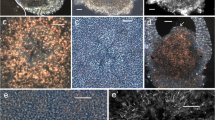Abstract
We investigated morphology, dynamics and origin of cells surrounding the mouth of Hydra vulgaris using the monoclonal antibody L96. This antibody recognises a one cell-thick ring of endodermal epithelial cells exactly at the boundary between endoderm (gastrodermis) and ectoderm (epidermis). L96+ cells can stretch considerably without any cell rupture during mouth opening. Thus, our data prove the existence of a distinct cell population defining hydra's mouth. A model for mouth opening is proposed and the significance of L96+ cells for boundary formation between ectoderm and endoderm is discussed.
Similar content being viewed by others
References
Beams HW, Kessel RG, Shih CC-YY (1973) The surface features of Hydra as revealed by scanning electron microscopy. Trans Am Micros Soc 92:161–175
Bibb C, Campbell RD (1973) Tissue healing and septate desmosome formation in Hydra. Tissue Cell 5:161–175
Bode PM, Bode HR (1984) Formation of pattern in regenerating tissue pieces of Hydra attenuata II. Degree of proportion regulation is less in the hypostome and tentacle zone than in the tentacles and basal disc. Dev Biol 103:304–312
Campbell RD (1985) Does Hydra have a mouth (when it is closed). Arch Sc Genève 38:359–370
Campbell RD (1987) Structure of the mouth of Hydra spp. A breach in the epithelium that disappears when it closes. Cell Tissue Res 249:189–197
Couso JP, Bishop SA, Martinez-Arias A (1994) The wingless signalling pathway and the patterning of the wing margin in Drosphila. Development 102:621–636
David CN (1973) Quantitative method for maceration of Hydra tissue. Roux's Arch Dev Biol 171:259–263
David CN, Campbell RD (1972) Cell cycle kinetics and development of Hydra attenuata. I. Epithelial cells. J Cell Sci 11:557–568
Diaz-Benjumea F, Cohen SM (1993) Interaction between dorsal and ventral cells in the imaginal disc directs wing development in Drosophila. Cell 75:741–752
Dübel S (1989) Cell differentiation in the head of Hydra. Differentiation 41:99–109
Greber MJ, David CN, Holstein TW (1992) A quantitative method for separation of living Hydra cells. Roux's Arch Dev Biol 201:296–300
Grimmelikhuijzen CJP (1983) FMRFamide immunoreactivity is generally occurring in the nervous system of Coelenterates. Histochemistry 78:361–381
Grimmelikhuijzen CJP (1985) Antisera to the sequence Arg-Pheamide visualize neural centralization in hydroid polyps. Cell Tissue Res 241:171–182
Grimmelikhuijzen CJP, Dockray GJ, Schot LPC (1982) FMRFamide-like immunoreactivity in the nervous system of Hydra. Histochemistry 73:499–508
Hardin MA, Keller R (1988) The behavior and function of bottle cells during gastrulation of Xenopus laevis. Development 103:211–230
Holstein TW, David CN (1990) Cell cycle length, cell size, and proliferation rate in Hydra stem cells. Dev Biol 142:392–400
Holstein TW, Tardent P, Campbell RD (1991) Identity crisis. Nature 346:21
Ingham PW, Martinez Arias A (1992) Boundaries and fields in early embryos. Cell 66:221–235
Kinnamon JC, Westfall JA (1981) A three dimensional serial reconstruction in the hypostome of a Hydra. J Morphol 168:321–329
Koizumi O, Bode HR (1986) Plasticity in the nervous system of adult Hydra. I. The position-dependent expression of FMRF-amide-like immunoreactivity. Dev Biol 116:407–421
Loomis WF, Lenhoff HM (1956) Growth and sexual differentiation of Hydra in mass culture. J Exp Zool 132:555–574
Meinhardt H (1983) Cell determination boundaries as organizing regions for secondary embryonic fields. Dev Biol 96:375–385
Meinhardt H (1991) Determination boundaries as organizing regions in the gereration of secondary embryonic fields: the initiation of legs and wings. Sem Dev Biol 2:129–138
Muscatine L, Lenhoff HM (1965) Symbiosis of Hydra and algae. I. Effect of some environmental cations on growth of symbiotic and aposymbiotic Hydra. Biol Bull Mar Biol Lab Woods Hole 128:415–424
Schmidt T, David CN (1986) Gland cells in Hydra: cell cycle kinetics and development. J Cell Sci 85:197–215
Tamm SL, Tamm S (1991) Reversible epithelial adhesion closes the mouth of Beroë, a carnivorous marine jelly. Biol Bull 181:463–473
tamm SL, Tamm S (1993) Dynamic control of cell-cell adhesion and membrane-associated actin during food-induced mouth opening in Beroë. J Cell Sci 106:355–364
Technau U, Holstein TW (1992) Cell sorting during the regeneration of Hydra of reaggregated cells. Dev Biol 151:117–127
Technau U, Holstein TW (1995) Head formation in Hydra is different at apical and basal levels. Development (in press)
Westfall JA, Townsend JW (1976) Stereo SEM applied to the study of feeding behavior in Hydra. Scanning electron microscopy part VIII. Proceedings of the workshop on Zoological Applications of SEM. IIT Research Institute Chicago, Chicago, pp 563–568
Wood RL (1979a) The fine structure of the hypostome and mouth of Hydra. I. Scanning electron microscopy. Cell Tissue Res 199:307–319
Wood RL (1979b) The fine structure of the hypostome and mouth of Hydra. II. Transmission electron microscopy. Cell Tissue Res 199:319–338
Author information
Authors and Affiliations
Rights and permissions
About this article
Cite this article
Technau, U., Holstein, T.W. Boundary cells of endodermal origin define the mouth of Hydra vulgaris (Cnidaria). Cell Tissue Res 280, 235–242 (1995). https://doi.org/10.1007/BF00307794
Received:
Accepted:
Issue Date:
DOI: https://doi.org/10.1007/BF00307794




